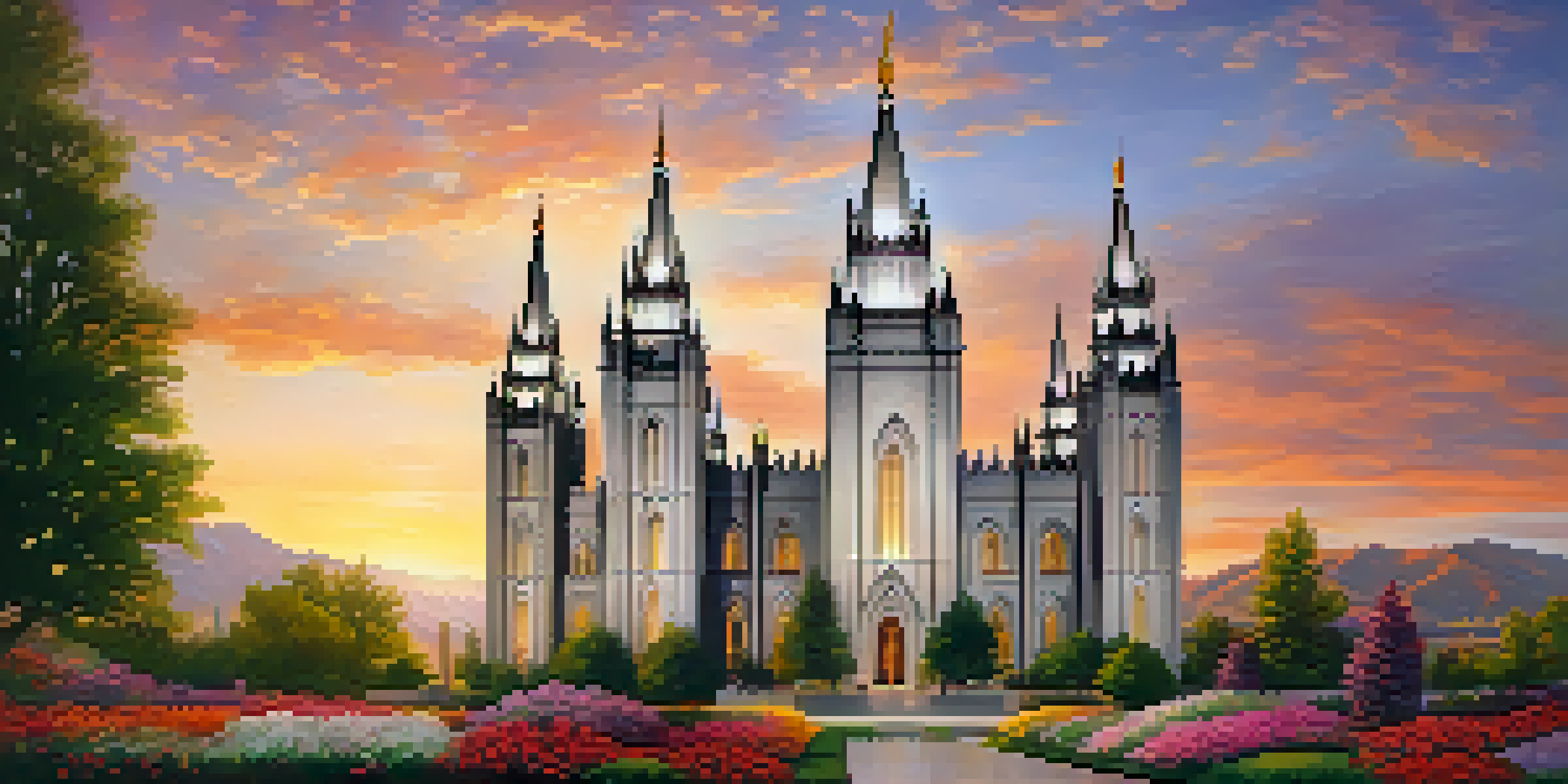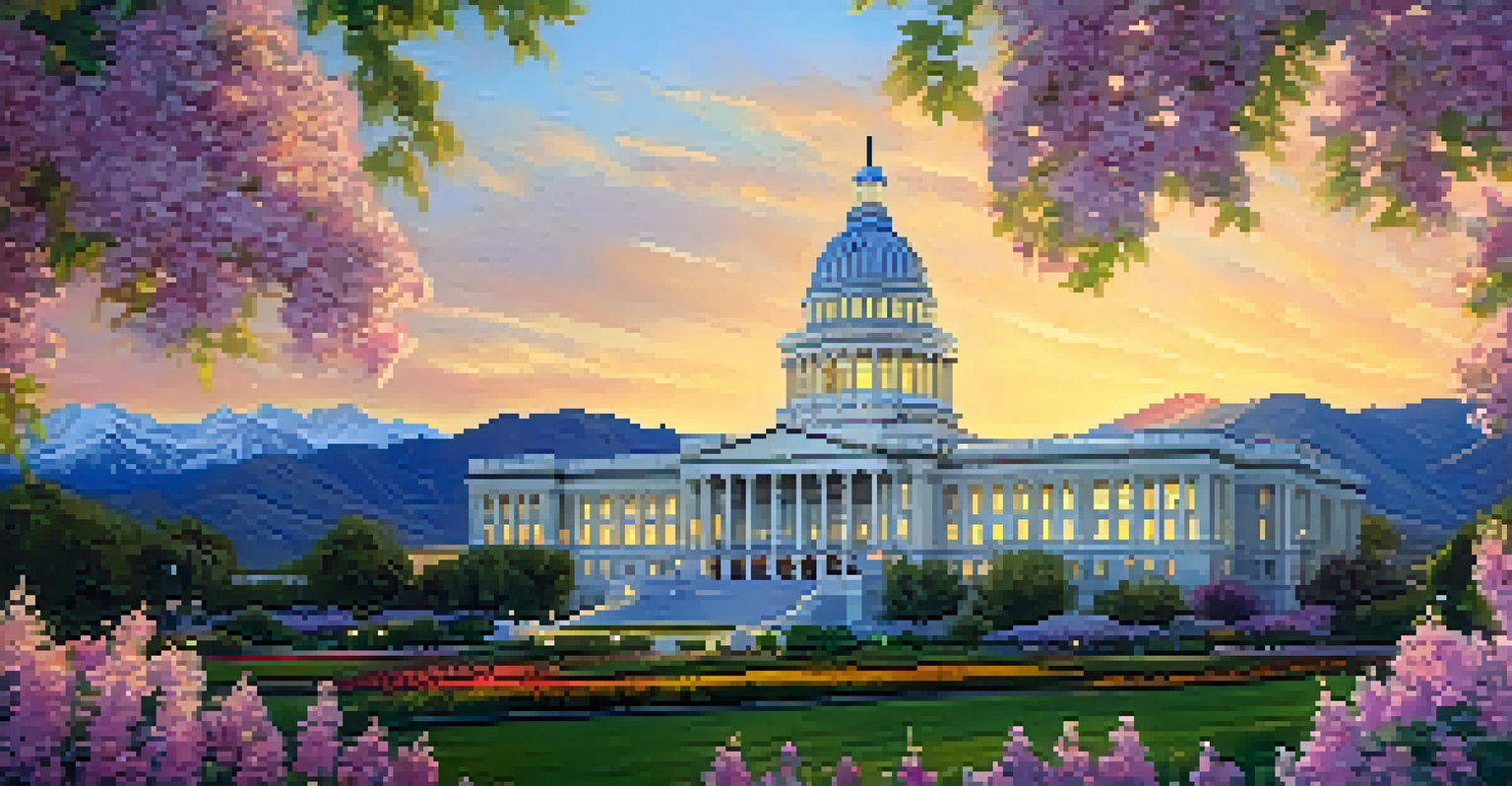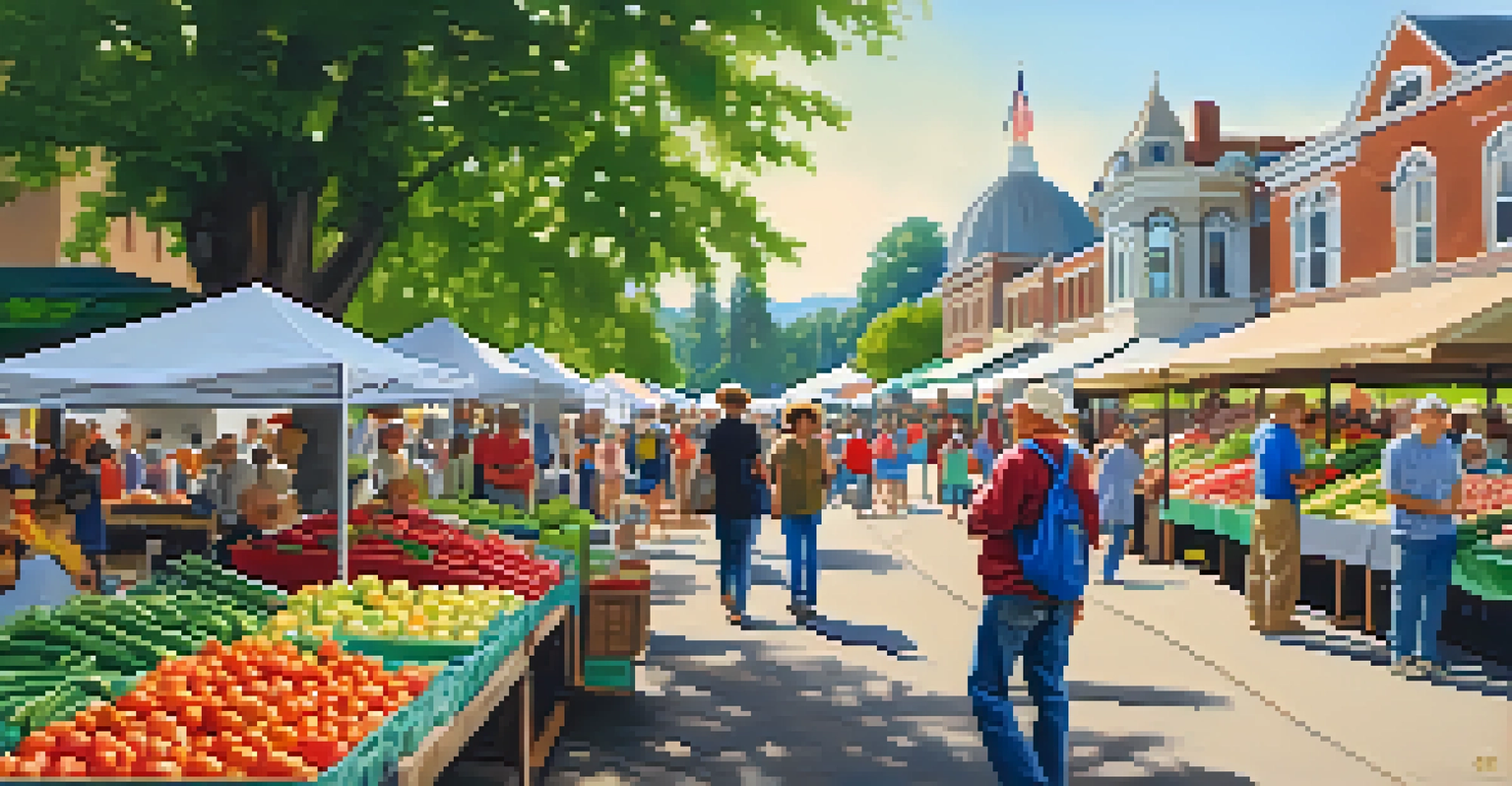Historic Landmarks in Salt Lake City: A Cultural Journey

The Majestic Salt Lake Temple: A Symbol of Faith
The Salt Lake Temple stands as a cornerstone of the city's identity, showcasing stunning Gothic and Romanesque architecture. Completed in 1893, this iconic structure is not just a place of worship but also a testament to the faith and perseverance of the early Latter-day Saints. Visitors are often captivated by its intricate stone carvings and majestic spires that reach toward the heavens.
Architecture is the thoughtful making of space.
As you stroll around the temple, the beautifully landscaped grounds invite you to pause and reflect. The serene atmosphere offers a perfect backdrop for photos and quiet contemplation. This landmark serves as a hub for learning about the history and beliefs of the Church of Jesus Christ of Latter-day Saints, making it a must-visit for anyone curious about the local culture.
Tour options are available for those who want to delve deeper into the temple's significance. Guides share fascinating stories about its construction and the community's role in its history. Whether you're religious or simply appreciate stunning architecture, the Salt Lake Temple is a highlight of any visit.
The Utah State Capitol: A Beacon of Governance
Perched on Capitol Hill, the Utah State Capitol is an architectural wonder that embodies the spirit of democracy. Its grand dome, reminiscent of the U.S. Capitol in Washington, D.C., is surrounded by beautifully manicured gardens, offering panoramic views of the city and the majestic Wasatch Range. This building houses the offices of the Governor and the Utah Legislature, making it a vital part of state governance.

Visitors can explore the Capitol through guided tours that highlight its rich history and stunning interiors. The rotunda features impressive murals and historical artifacts, giving insight into Utah's journey from a territory to a state. It’s an educational experience that showcases the importance of civic engagement and local governance.
Salt Lake Temple: Faith and Beauty
The Salt Lake Temple is a stunning architectural marvel that symbolizes the faith and dedication of the Latter-day Saints.
Don't forget to take a moment to appreciate the architecture, which combines neoclassical elements with Utah's natural resources, like the pink granite sourced from the nearby Wasatch Mountains. The Utah State Capitol is not just a functional building; it’s a symbol of the state's democratic values and history.
The Historic Pioneer Park: A Glimpse into the Past
Pioneer Park, nestled in the heart of Salt Lake City, is a vibrant reminder of the city’s early days. Once a bustling hub for pioneers arriving in the 1800s, the park now hosts community events, farmers' markets, and art festivals, bringing history and culture together. As you walk through its paths, you can almost hear the echoes of the past mingling with the laughter of families enjoying the present.
Nature is not a place to visit. It is home.
The park features historical monuments, including a tribute to the pioneers and the well-known Salt Lake City Farmers Market, which highlights local produce and crafts. This connection to the community's agricultural roots is a delightful way to experience local culture while enjoying fresh food and handcrafted goods.
Pioneer Park serves as a gathering place that celebrates both the history and the vibrancy of Salt Lake City today. It’s a lovely spot to relax, reflect, and appreciate how far the city has come since those early pioneering days.
The Natural History Museum of Utah: Where Nature Meets Culture
The Natural History Museum of Utah offers a fantastic blend of nature and culture, showcasing the rich geological and biological history of the region. Nestled in the foothills of the Wasatch Range, the museum’s stunning architecture mirrors the natural beauty surrounding it. With exhibits ranging from ancient dinosaurs to Native American history, there’s something for everyone.
Visitors can explore interactive displays that engage all ages, making learning fun and memorable. The museum's extensive collection includes fossilized remains, cultural artifacts, and immersive environments that transport you through time. This unique approach provides a holistic view of Utah’s past and its inhabitants.
Utah's Capitol: History and Governance
The Utah State Capitol not only represents the spirit of democracy but also serves as a vital hub for understanding the state's governance.
Don’t miss the breathtaking views from the museum's terraces, where you can connect with nature while reflecting on the rich history you’ve just experienced. The Natural History Museum is not just a place to learn; it’s an invitation to appreciate the intricate relationship between humans and the environment.
The Utah Museum of Fine Arts: A Cultural Oasis
The Utah Museum of Fine Arts is a cultural gem that showcases an impressive collection of art from around the globe. With works that span centuries and cultures, the museum invites visitors to explore diverse artistic expressions. From classic European paintings to contemporary installations, there’s a treasure trove of creativity waiting to be discovered.
The museum also hosts rotating exhibitions, educational programs, and community events that foster a deeper understanding of art and its relevance. These initiatives encourage visitors of all ages to engage with art, transforming the museum into a lively hub of creativity and dialogue.
Wandering through the galleries, you’ll find yourself inspired by the stories behind each piece. The Utah Museum of Fine Arts emphasizes the importance of art in shaping cultural identity, making it a vital stop for anyone seeking to understand the artistic landscape of the region.
The Historic District: Walking Through Time
The Historic District of Salt Lake City is like stepping into a living museum, where stunning architecture tells the stories of the past. This area is home to beautifully preserved buildings that reflect various architectural styles, from Victorian to Romanesque. As you walk along the streets, you can feel the rich history that permeates the air, giving you a sense of connection to the city’s roots.
One of the highlights is the City and County Building, an architectural marvel that showcases intricate stonework and a grand clock tower. This building is not only functional but also a symbol of the community’s commitment to preserving its heritage. Each structure in the district has its own story, contributing to the overall narrative of Salt Lake City.
Great Salt Lake: Nature's Wonder
The Great Salt Lake is a unique natural wonder that plays a crucial role in the region's ecology and offers recreational opportunities for visitors.
Exploring the Historic District is an engaging way to learn about the city’s past while enjoying the charm of its streets. With each step, you encounter remnants of history that invite reflection on how the past continues to shape the present.
The Tracy Aviary: A Sanctuary for Birds and People
The Tracy Aviary, located in Liberty Park, is a delightful escape for nature lovers and families alike. This sanctuary is home to a diverse array of bird species, many of which are endangered or rescued. The aviary offers visitors an opportunity to learn about avian conservation while enjoying close encounters with these magnificent creatures.
Throughout the aviary, educational programs and feeding sessions provide insights into the behaviors and habitats of various birds. The staff is passionate about wildlife and eager to share their knowledge, making each visit an interactive learning experience. Whether you’re a bird enthusiast or just looking for a fun family outing, the aviary caters to all.

In addition to its impressive collection of birds, the Tracy Aviary provides a peaceful environment for relaxation and reflection. With beautiful walking paths and picnic areas, it's a perfect spot to unwind while appreciating the beauty of nature. Visiting the aviary is not just about seeing birds; it's about connecting with the environment and understanding our role in conservation.
The Legacy of the Great Salt Lake: Nature's Masterpiece
The Great Salt Lake is more than just a body of water; it's a natural wonder that holds significant historical and ecological importance. As the largest saltwater lake in the Western Hemisphere, it has shaped the landscape and history of Salt Lake City. The lake’s unique ecosystem supports a variety of wildlife, making it a crucial habitat for migratory birds and other species.
Visitors can explore the areas surrounding the lake, where recreational activities like hiking, birdwatching, and photography abound. The stunning sunsets reflecting off the water create a picturesque backdrop, attracting nature lovers and photographers alike. This natural beauty serves as a reminder of the importance of preserving our environment for future generations.
Understanding the legacy of the Great Salt Lake offers insight into the region's history and its inhabitants, both human and animal. It’s a place where nature and culture intertwine, inviting you to reflect on the beauty and complexity of the world around us. A visit to the lake is not just a trip; it’s an experience that deepens your appreciation for the natural wonders that surround Salt Lake City.